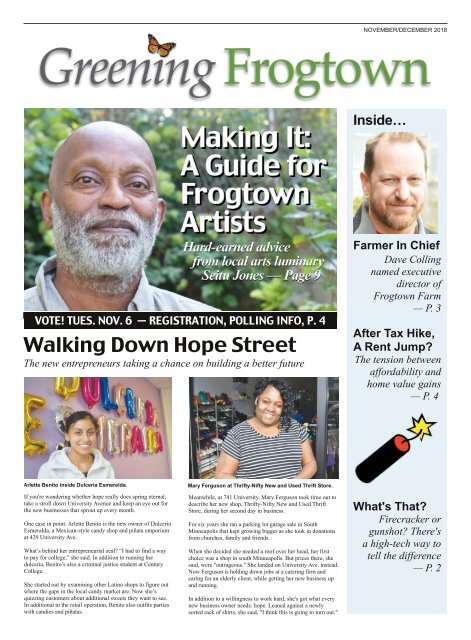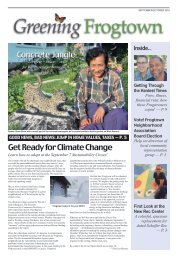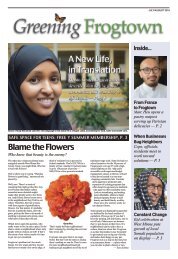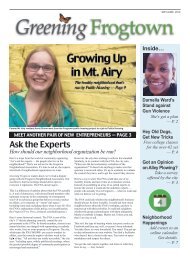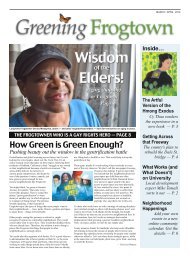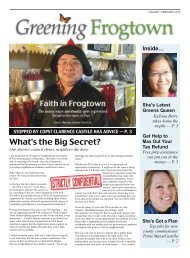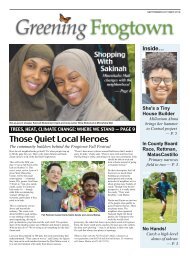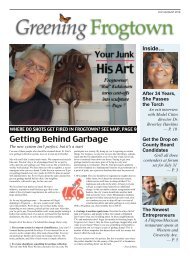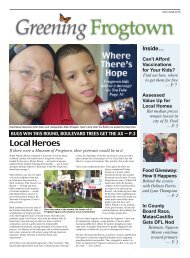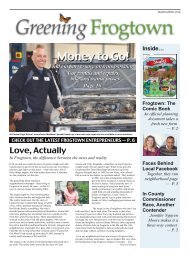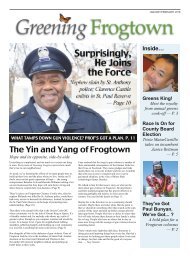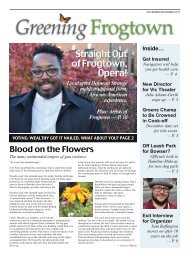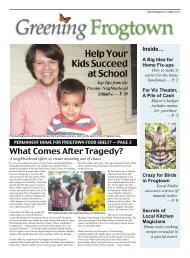GreeningFrogtownNovDec
You also want an ePaper? Increase the reach of your titles
YUMPU automatically turns print PDFs into web optimized ePapers that Google loves.
NOVEMBER/DECEMBER 2018<br />
Inside…<br />
VOTE! TUES. NOV. 6 — REGISTRATION, POLLING INFO, P. 4<br />
Walking Down Hope Street<br />
The new entrepreneurs taking a chance on building a better future<br />
Farmer In Chief<br />
Dave Colling<br />
named executive<br />
director of<br />
Frogtown Farm<br />
— P. 3<br />
After Tax Hike,<br />
A Rent Jump?<br />
The tension between<br />
affordability and<br />
home value gains<br />
— P. 4<br />
Arlette Benito inside Dulceria Esmerelda.<br />
If you're wondering whether hope really does spring eternal,<br />
take a stroll down University Avenue and keep an eye out for<br />
the new businesses that sprout up every month.<br />
One case in point: Arlette Benito is the new owner of Dulceria<br />
Esmeralda, a Mexican-style candy shop and piñata emporium<br />
at 429 University Ave.<br />
What’s behind her entrepreneurial zeal? “I had to find a way<br />
to pay for college,” she said. In addition to running her<br />
dulceria, Benito’s also a criminal justice student at Century<br />
College.<br />
She started out by examining other Latino shops to figure out<br />
where the gaps in the local candy market are. Now she’s<br />
quizzing customers about additional sweets they want to see.<br />
In additional to the retail operation, Benito also outfits parties<br />
with candies and piñatas.<br />
Mary Ferguson at Thrifty-Nifty New and Used Thrift Store.<br />
Meanwhile, at 741 University, Mary Ferguson took time out to<br />
describe her new shop, Thrifty-Nifty New and Used Thrift<br />
Store, during her second day in business.<br />
For six years she ran a parking lot garage sale in South<br />
Minneapolis that kept growing bigger as she took in donations<br />
from churches, family and friends.<br />
When she decided she needed a roof over her head, her first<br />
choice was a shop in south Minneapolis. But prices there, she<br />
said, were "outrageous." She landed on University Ave. instead.<br />
Now Ferguson is holding down jobs at a catering firm and<br />
caring for an elderly client, while getting her new business up<br />
and running.<br />
In addition to a willingness to work hard, she's got what every<br />
new business owner needs: hope. Leaned against a newly<br />
sorted rack of shirts, she said, "I think this is going to turn out."<br />
What's That?<br />
Firecracker or<br />
gunshot? There's<br />
a high-tech way to<br />
tell the difference<br />
— P. 2
THE SAFETY FILE<br />
Shots Fired? Who Knows?<br />
Would Shot Spotter technology improve safety, or just add cost?<br />
Regular students of the Frogtown<br />
Neighbors Facebook page know that next<br />
to lost kitties, a major concern is<br />
whenever shots are fired in Frogtown.<br />
There’s typically a fevered exchange<br />
about when, where and what happened.<br />
And the result is, well, not much.<br />
In the year from September 24, 201 7 to<br />
September 24, 201 8, St. Paul police<br />
recorded 1 38 calls from Frogtowners<br />
who reported gun shots. Reported calls<br />
and actual shots fired are, however, an<br />
entirely different matter. The criminology<br />
literature estimates that 75 percent or<br />
more of gunshots are never reported.<br />
At a recent meeting regarding St. Paul<br />
gun violence, public officials and social<br />
service agency reps wrestled with the<br />
question of what can be done. Afterward,<br />
assistant Ramsey County Attorney<br />
Elizabeth Lamin wondered aloud whether<br />
it’s time to invest in Shot Spotter<br />
technology for St. Paul.<br />
Shot Spotter uses a network of elevated<br />
microphones to triangulate on the sound<br />
of gunfire. The data is beamed to a<br />
Firecracker, slammed door, or gun shot? It's often tough to tell the difference.<br />
Newark, CA office, analyzed to separate<br />
gunfire from similar sounds such as<br />
fireworks or backfires, then sent to police<br />
squad cars in the 90-plus cities that<br />
subscribe to the service. The data often<br />
traverses hundreds of miles, but reaches<br />
cops’ eyes in under a minute, and is<br />
accurate within a few yards.<br />
A subscription costs $65,000 to $80,000<br />
per year per square mile — roughly the<br />
area from Lexington to Dale St., and from<br />
Pierce Butler to I-94.<br />
Right now St. Paul Police spokesperson<br />
Steve Linder says the system isn’t on the<br />
department’s list of must-have items.<br />
But in Minneapolis, where the system has<br />
been in place for about five years, police<br />
spokesperson John Elder says, “It’s been<br />
an exceptionally useful tool for us. It can<br />
identify and pinpoint to a much closer<br />
degree where shots are fired. The mapping<br />
is within three meters. We know the<br />
number of rounds, sometimes the different<br />
calibers of gun. It’s got the complete faith<br />
of officers here, who truly believe in it.”<br />
Nonetheless, Elder says there’s been no<br />
formal evaluation he knows of that<br />
systematically links the technology to<br />
arrests and prosecutions in Minneapolis.<br />
In the view of Metro State criminologist<br />
James Densley, the upside of such databased<br />
policing solutions is that it gives<br />
cops tools to predict where crime happens<br />
most often, and to focus on those areas.<br />
So Shot Spotter could be useful for<br />
mapping where gunfire actually occurs,<br />
and see if or where it’s clustered. By<br />
harnessing this data, says Densley, “we<br />
can know how best to allocate resources.”<br />
Is this technology likely to deter crime by<br />
itself? Densley doesn’t think so. But he<br />
can imagine a pilot program where police<br />
use Shot Spotter within a small area that<br />
has a high number of shots-fired<br />
complaints — say, for instance, Frogtown<br />
— and then use that data to engage with<br />
neighbors about acceptable strategies to<br />
put a lid on gunfire.<br />
Asked what he made of that idea,<br />
Frogtown-area City Councilman Dai Thao<br />
said it's worth considering. The potential<br />
rub is a familiar one, he says: in a world<br />
of limited budgets, the cost is significant,<br />
both for installation and ongoing<br />
maintenance.<br />
PAGE 2 NOVEMBER/DECEMBER JULY / AUGUST 2018<br />
6
FROGTOWN NEWS<br />
Who's That Caped Crusader? Frog‐ish<br />
Freelance Organizer Starts Campaign<br />
Dave Colling brings an organizing background to his position at Frogtown Farm.<br />
At Frogtown Farm, a New Director<br />
Frogtown Farm installed a new executive<br />
director in late September, naming Dave<br />
Colling to replace Eartha Borer Bell, who<br />
stepped down to manage a growing family.<br />
Colling comes to the job having served as<br />
director of the Harrison Neighborhood<br />
Association in Minneapolis. He also<br />
managed Rep. Keith Ellison’s 2006 run<br />
for Congress.<br />
So what does he think comes next for the<br />
three-year old urban farm, located in the<br />
middle of a city park?<br />
“The next step is to reach out and make<br />
more community connections," he said.<br />
"This is the community’s farm. We want<br />
to know what they want from us. We<br />
spent the first few years learning what<br />
people wanted to see, what it should look<br />
like, how the farm should grow. Then we<br />
built it. Now it’s time to go back and say,<br />
okay, we’re here now, we’ve done the<br />
build. What would you like to see next?"<br />
What about five years from now?<br />
“The first thing is, you’d see a nice big,<br />
energy-efficient building here. Maybe<br />
there would be a commercial kitchen in<br />
there, space for a business incubator, art<br />
space, community space. That would be<br />
the greatest thing.<br />
“There would be a real greenhouse to<br />
replace the hoop house we’ve got now. I’d<br />
want to see people who live here working<br />
in the fields. We’d keep working with<br />
Feeding Frogtown (the food giveaway at<br />
City School at Lafond and Western)."<br />
"This land could produce a lot more food<br />
that we currently do. It’s a question of<br />
finding a balance between food<br />
production and programming.”<br />
For all the chatter about block-by-block<br />
organizing in Frogtown, it’s rare that<br />
anyone does much about it. A recent<br />
exception is the freelance organizing<br />
effort that<br />
Frogtowner Abu<br />
Nayeem is<br />
undertaking from<br />
his Sherburne<br />
Ave. home.<br />
Nayeem was born<br />
in Bangladesh,<br />
raised in Queens,<br />
NY, and moved to<br />
Frogtown about a<br />
year ago. After<br />
landing here, he<br />
decided that he<br />
wanted to start<br />
organizing<br />
neighbors about<br />
issues important<br />
to them.<br />
Abu Nayeem gets wardrobe help.<br />
He started with a few simple strategies.<br />
He published a survey on Facebook<br />
asking neighbors to list their big<br />
concerns. He organized a series of<br />
evening walks for neighbors to meet each<br />
other and take in the local sites. He<br />
showed up in a home-made frog costume<br />
at events such as National Night Out, then<br />
patiently suffered the children who<br />
grabbed his headgear. He called a<br />
meeting at the Rondo Library for people<br />
to meet and talk about his survey results.<br />
The library meeting revealed the rift<br />
between what people say they want —<br />
block-level organizing — and what will<br />
get them to leave the house. A meeting at<br />
the library wasn’t it. It drew a pair of<br />
residents and a Greening Frogtown<br />
reporter.<br />
and party slated to be held at a local cafe,<br />
the Tin Cup. The fundraising effort raised<br />
$4,000. The money went toward paying<br />
for a year’s worth of service on about 25<br />
Xcel-installed alley<br />
lights, 20 of which<br />
have already been<br />
put up.<br />
The same could be<br />
done here, Nayeem<br />
says, but it will take<br />
a group of activists<br />
to learn whether a<br />
significant number<br />
of people want their<br />
alley lit, make sure<br />
that the light<br />
distribution is<br />
equitable, and then<br />
work out the details<br />
of raising money<br />
and getting lights<br />
installed. Interested? Email him at<br />
anayeem1 @gmail.com<br />
The goal isn’t so much to light the alleys.<br />
“It’s to build relationships and have an<br />
authentic conversation among people<br />
here,” he says.<br />
Nayeem’s latest maneuver was to<br />
nominate himself to the Frogtown<br />
Neighborhood Association board, where<br />
he’ll join a slate of eight other new board<br />
members. What does he hope to<br />
accomplish there? “I want to make sure<br />
that community members know what’s<br />
going on, and that we treat people here<br />
with respect.”<br />
One of those residents was Johnny<br />
Howard, the former director of the<br />
Thomas Dale Block Club. That<br />
organization, active in the late 90s and<br />
early 2000s, once included about 600<br />
members in a network of block clubs.<br />
Howard’s advice to Nayeem: don’t get<br />
discouraged when nobody shows up. He<br />
recalled meeting after meeting in the<br />
TDBC’s early days when two people<br />
would have been a crowd.<br />
NEW FEATURES AT HMONG MUSEUM: Above,<br />
Hmong Cultural Center’s Txongpao Lee and<br />
Mark Pfeifer show off a new interactive feature —<br />
an iPad-based video collection (right) depicting aspects<br />
of Hmong culture — at their museum located in the second<br />
floor office at 375 University Ave.<br />
The videos explain traditional embroidery and story cloths, depict people playing<br />
various instruments and show their roles in weddings and funerals. Along with<br />
panels that set out the Hmong path from Southeast Asia to St. Paul — plus a rich<br />
display of clothing, farming and hunting tools, instruments, and household<br />
objects — the museum is a great introduction to the quick and radical changes<br />
that occurred in the lives of Frogtown’s Hmong residents.<br />
Walk-in visitors are welcome from 9 am to 6 pm, Monday through Friday, with a<br />
suggested donation of $5. Find out more at hmonghistorycenter.org, or call ahead<br />
at 651 -91 7-9937.<br />
The other resident at the Rondo<br />
meeting, Lynn Kensy, said that for<br />
her, poor street and alley lighting was<br />
a major safety issue. Nayeem’s next<br />
move was to conduct a street and alley<br />
lighting survey with Kensey and<br />
Frogtowner Norma Hakizimana. They’re<br />
method wasn’t strictly scientific. They<br />
prowled the streets at night and declared a<br />
section underlit when it was so dark they<br />
couldn't see any shadows.<br />
Using the data they collected, Nayeem<br />
put together a map that identified the<br />
darkest alleys. He then connected with<br />
Dee Walsh, a North End resident who<br />
started an alley light campaign after a<br />
shooting outside her house. Walsh made<br />
contacts with North End businesses,<br />
asking them to donate prizes for a raffle<br />
GREENS ROYALTY: WHO WILL IT BE?<br />
Get set for the social event of the<br />
season — the third annual Greens<br />
Cook-off, set for 4:30-7:30 pm,<br />
Saturday, Dec. 1 at new, larger venue<br />
this year, Mt. Olivet Baptist Church, 451<br />
Central Ave. W.<br />
Last year's champ in the celebrity<br />
judging category was Carolyn Brown,<br />
above, while Yeng Moua took the<br />
people's choice title. This year<br />
promises to be another hard fought<br />
contest, featuring a meal, a mountain<br />
of greens, plus music and<br />
speechifying. It's all free. Don't miss it!<br />
NOVEMBER/DECEMBER 2018 PAGE 3
FROGTOWN NEWS<br />
Ramsey County Board Candidates:<br />
What's Their Big Idea for Frogtown?<br />
In these last days before the November 6<br />
election, we asked the two Ramsey<br />
County board candidates — incumbent<br />
Janice Rettman and challenger Trista<br />
MatasCastillo, to describe their biggest<br />
ideas for Frogtown.<br />
The county board seat comes with vast<br />
responsibility for oversight of government<br />
social service programs, parks, courts,<br />
voter registration, policing, libraries,<br />
roads and much more. We hoped that<br />
boiling a question down to an ultra-local<br />
level, readers might catch a revealing<br />
glimpse of the candidates.<br />
Rettman was first elected to the county<br />
board in 1 997, after serving on the city<br />
council for ten years. MatasCastillo was<br />
in the military for 1 6 years, then worked<br />
as a Habitat for Humanity organizer. She<br />
is also the founder of the Women Veterans<br />
Initiative, a nonprofit organization that<br />
advocates for female veterans.<br />
Until this election, Rettman has typically<br />
faced nominal opposition, or no<br />
challenger at all, in her races for the<br />
District 3 seat. That changed this time<br />
around, when MatasCastillo secured the<br />
DFL endorsement at the March party<br />
convention. In the August primary she<br />
gathered 4,022 votes to Rettman’s 2,671 .<br />
So what are Rettman and MatasCastillo’s<br />
big ideas for Frogtown? Take a look.<br />
MatasCastillo: "Dale Street was once the<br />
"Main Street" of Frogtown, a vibrant,<br />
walkable, and transit-connected corridor<br />
that supported thriving neighborhood<br />
businesses and social institutions. Today,<br />
because of decisions made over the last<br />
few generations by local leaders<br />
(including the incumbent<br />
Commissioner), most of that has<br />
disappeared, replaced by a landscape of<br />
vacant lots that feels more like a freeway<br />
than a neighborhood.<br />
"Roads in the county system need to be<br />
able to move traffic efficiently, but they<br />
shouldn't do that at the expense of the<br />
neighborhoods they pass through,<br />
especially in disinvested areas like<br />
Frogtown. We need to redesign Dale<br />
Street to be safe and pleasant for people<br />
of all ages and abilities, and work<br />
together to rebuild a vibrant Main Street<br />
that can again function as the heart of<br />
Frogtown. We need to explore enhanced<br />
bus service on Dale (like the A Line on<br />
Snelling), and begin a community input<br />
and design process to explore what Dale<br />
Street's future should be."<br />
Rettman: "I am privileged to represent<br />
Frogtown. Through good and bad times,<br />
I fight for Frogtown to be recognized by<br />
Ramsey County — because you work<br />
hard for your family and expect this work<br />
from me.<br />
"I often “doorknock” Frogtown for<br />
community issues. You said that day care,<br />
elder care, job search, and family services<br />
are important County services. So, I<br />
worked for more Frogtown families<br />
having early childhood education, and I<br />
fought for more environmentally-clean<br />
job sites with living-wage jobs.<br />
"Still, more work is needed. I will<br />
advocate using the State’s Environmental<br />
Response Fund for more living-wage job<br />
sites. Together, we will work because<br />
hardworking Frogtown residents deserve<br />
the best."<br />
Get Ready to Vote November 6<br />
Don't get caught ballot-less on November 6. Get registered, find your polling place<br />
and see a sample ballot now. The easy way to get all this information? Go to<br />
tinyurl.com/frogtownvote for a thorough rundown. You'll also find help there on<br />
absentee and early voting if you can't get to the polls on November 6.<br />
Good News! Local Home Values Are Up<br />
Bad News! Local Home Value Are Up<br />
We’re just a few weeks away from an<br />
annual government ritual — the mid-<br />
November date when Ramsey County<br />
sends out its property tax statements for<br />
the year to come. For many Frogtown<br />
homeowners and renters, the envelope is<br />
not likely to hold good news.<br />
Property taxes are based in part on the<br />
value of your home, as figured by the<br />
county assessor’s office, and in part on<br />
the tax rates set by city and county<br />
government leaders to fund public<br />
programs. For 201 9, the City Council and<br />
Mayor Melvin Carter are looking at an<br />
11 .5 percent tax increase, with the county<br />
adding an additional 4.5 percent.<br />
Meanwhile, Frogtown leads the city in the<br />
percentage gain of home values, with the<br />
median (half under, half over) change<br />
from 201 8 to 201 9 at 1 6.3 percent. In<br />
201 8 the median home value here was<br />
$111 ,700. For 201 9, it’s $1 29,900.<br />
The explanation for Frogtown’s big<br />
jump? Homes in other parts of town<br />
regained value more quickly after the<br />
2008 financial crisis. Frogtown is making<br />
up for lost time now. Lower house prices<br />
here spur buyer demand, which increases<br />
prices, which then leads to higher<br />
assessed values. It’s another of life’s<br />
vicious circles. Nonethless, median home<br />
values here are lower than any other St.<br />
Paul neighborhood except for Dayton’s<br />
Bluff.<br />
How does that value leap work out in<br />
dollars and cents? That changes for each<br />
particular house. But here’s a real-life<br />
PAGE 4 NOVEMBER/DECEMBER 2018
example from an owner-occupied home<br />
on Van Buren Ave. In 201 8, the assessed<br />
value was $11 4,900. For 201 9, it’s<br />
$1 40,900. The tax and assessment bill<br />
will increase from $1 ,556 to $1 ,988. If the<br />
referendum for increased school funding<br />
passes in the Nov. 6 election, another<br />
$1 09 gets tacked on, for a total of $2,097,<br />
or a $542 gain.<br />
For renters — about 62 percent of<br />
Frogtown residents — the tax load on<br />
property can be even more significant.<br />
Owner-occupants get a special tax break<br />
that allows them to deduct about $25,550<br />
from the assessed value of a median<br />
priced Frogtown home. No such luck for<br />
renters, since rental property doesn’t get<br />
this tax deal. Here’s another real-world<br />
example on how this works out on a<br />
Sherburne Ave. single-family rental home.<br />
The 201 8 assessed value was $88,500.<br />
For 201 9, it’s $11 5,1 00. Assuming the<br />
school referendum passes, taxes and<br />
assessments will increase from $1 ,532 to<br />
$2,027, a $495 jump.<br />
Which is to say, landlords may be looking<br />
to recover higher costs by raising rents. If<br />
you’re a renter who’s willing to do some<br />
digging, you can figure out whether your<br />
landlord is actually looking at a<br />
significant tax hike based on assessed<br />
value gains. Go to tinyurl.com/FrogtownTax,<br />
enter your address, hit search, and click on<br />
the parcel ID in the upper left corner.<br />
Scroll down to Statements and Notices,<br />
and compare the 201 8 to 201 7 "Value<br />
Notice." Statements for actual taxes<br />
payable in 201 9 should appear in the<br />
same location by mid-November.<br />
As usual, there are a lot of ways to<br />
interpret tax facts. Higher taxes put a<br />
squeeze on those renters and homeowners<br />
who are already barely getting by. But for<br />
Frogtowners who bought a home at the<br />
height of the market before the 2008<br />
recession, increasing home values mean<br />
that someday, maybe, they won’t be<br />
underwater on their mortgage. For lowincome<br />
householders, the most likely path<br />
to generational wealth is a home that they<br />
own. That doesn’t work if values never<br />
increase. Higher taxes hurt today, but a<br />
house that’s worth less than when you<br />
bought it is a long-term loss. The big<br />
picture here: value gains are everything at<br />
once: good, bad and complicated.<br />
This old house: 1 6.3 percent assessed<br />
property value gains in Frogtown are<br />
the highest in St. Paul.<br />
FROGTOWN NEWS<br />
What Was This About?<br />
Maybe you noticed the signs that<br />
temporarily sprouted along Victoria and<br />
Minnehaha in September, declaring “We<br />
Will Not Be Moved,” and, on the flip<br />
side, “Black and Brown Owned: It’s<br />
Wilder.”<br />
So, what’s the story? First, some<br />
background. “It’s Wilder” refers to the<br />
Wilder Square Town Homes, 1 63 units of<br />
cooperatively-owned housing<br />
concentrated near the intersection of<br />
Minnehaha and Victoria. They were built<br />
by the Wilder Foundation between 1 973<br />
and 1 975, and managed by Wilder until<br />
2009. After a restructuring, Wilder got<br />
out of the management business. A local<br />
firm, Real Estate Equities, was later hired<br />
by the co-op’s resident-elected board to<br />
manage the property.<br />
A co-op is different than a straight rental<br />
apartment. Residents buy a share when<br />
they move in, and then own a piece of the<br />
pie. To make management decisions they<br />
elect a board, which is in charge of<br />
balancing shareholders' monthly costs<br />
versus the need to make timely repairs<br />
and improvements, among other issues.<br />
Residents’ monthly payments will likely<br />
seem like a bargain to most Frogtown<br />
renters. A studio apartment goes for $488<br />
per month, a one-bedroom for as little as<br />
$629, a two-bedroom for $787, and a<br />
three-bedroom for $881 . Ninety-three of<br />
those units are project-based Section 8, a<br />
housing assistance program that is<br />
attached to the property, while another 1 7<br />
units are occupied by residents who<br />
qualify for individual Section 8 vouchers,<br />
according to Terrence Troy, chairman of<br />
Real Estate Equities.<br />
The path that led to that sudden<br />
blossoming of “We Will Not Be Moved”<br />
signage began when Troy’s firm offered<br />
to buy out co-op members and take over<br />
ownership. Tenants who remained would<br />
become straight-up renters instead of<br />
shareholding owners. Like all renters,<br />
they’d be dealing with a landlord instead<br />
of a board they had elected. The buy-out<br />
offer created turmoil between residents<br />
who saw it as a chance to put buy-out<br />
money in their pocket, and others who<br />
believed it meant that ultimately<br />
they’d pay more for housing.<br />
Beyond this, the facts get murky. The<br />
town home board leadership didn’t want<br />
to discuss their internal affairs. No<br />
complaining about that — nothing says<br />
they have to. The resident most active in<br />
organizing against the buy out did not<br />
return phone calls. No problem there<br />
either. If he doesn’t want to talk, that’s<br />
his right. Troy at Real Estate Equities<br />
agreed to meet, and explained that in the<br />
face of so much contention, his firm had<br />
backed off its offer.<br />
The Frogtown Neighborhood<br />
Association, which helped tenants resist<br />
a buy-out and plant those signs, declined<br />
several times to discuss why they<br />
intervened in the affairs of another<br />
neighborhood resident-elected board,<br />
and what actions they took in support of<br />
tenants resisting a buy-out.<br />
OPENNESS AND FNA: AN OPINION<br />
In this issue we made an effort to do<br />
what newspapers often do — that is,<br />
find out what the people who<br />
represent us are up to. With the<br />
Frogtown Neighborhood Association,<br />
we weren't very successful.<br />
The FNA is one of the City of St.<br />
Paul’s 1 7 district councils, set up in<br />
1 975 to provide a link between city<br />
government and neighborhoods. By<br />
the city’s lights, the district councils<br />
“create opportunities for residents to<br />
learn about what is happening in their<br />
neighborhoods and collaborate with<br />
one another and city government to<br />
maintain and improve the quality of<br />
life in neighborhoods.” To pursue this<br />
work, the city allocated the FNA<br />
$61 ,41 8 in 201 8.<br />
As a non-profit organization, the FNA<br />
has no obligation under Minnesota law<br />
to talk about what it does. Whether<br />
that jibes with its mission is another<br />
question.<br />
We were unable to persuade the FNA<br />
to discuss why they intervened in the<br />
affairs of the Wilder Square Town<br />
Home board and shareholders, even<br />
though by festooning local streets<br />
with placards declaring, "We Will Not<br />
Be Moved," they made the dispute<br />
very public, albeit dimly understood<br />
by most passersby.<br />
It's an odd approach to "creating<br />
opportunities for residents to learn<br />
what is happening in their<br />
neighborhoods." But it's not the sole<br />
example. As of this writing (Oct. 25),<br />
the FNA does not publish its board<br />
agenda or minutes, list its board<br />
members or consistently update the<br />
calendar of events on its website. For<br />
the organization’s soon-to-be-installed<br />
new board, here's an obvious question:<br />
how much do neighbors deserve to<br />
know about what their citizen<br />
participation organization does for<br />
them?<br />
— Tony Schmitz<br />
NOVEMBER/DECEMBER 2018<br />
PAGE 5
PAGE 6<br />
NOVEMBER/DECEMBER 2018
NOVEMBER/DECEMBER 2018 PAGE 7
BIG IDEAS<br />
Greening Up Dale Street<br />
Here's a plan to turn an abandoned lot into a center to fight climate change on a local level<br />
PAGE 8 NOVEMBER/DECEMBER 2018
FROM THE COVER<br />
He Figured It Out for You<br />
Art elder Seitu Jones has advice for young Frogtown artists<br />
You’re a Frogtown artist and you’re looking<br />
for tips on how to turn your creative<br />
impulses into a living. Everyone’s got to find<br />
their own path in this tough racket. But that<br />
said, Frogtown’s most prominent artist, Seitu<br />
Jones, has time-tested advice developed over<br />
nearly a half-century of paying the bills via<br />
the arts.<br />
He’s recently been declared a McKnight<br />
Foundation Distinguished Artist, was the<br />
first-ever resident artist for the City of<br />
Minneapolis, created the art at the Dale and<br />
Rice St. Greenline Stations, was the brains<br />
behind the 2,000-guest public meal held on<br />
Victoria St., and was among the co-founders<br />
to Frogtown Farm, to cite just a few of his<br />
accomplishments.<br />
Here’s his memory of how he got on the arts<br />
path, and the practical and high-minded<br />
essentials for building up a lasting career.<br />
How did you get started?<br />
Back in the 70s, there wasn’t a real market<br />
here for art. I was often tempted to go to<br />
New York, but I had kids, and there was no<br />
way I could conceptualize picking up my<br />
kids and moving them there.<br />
Being a child of the 60s, I kept coming up<br />
with all these different philosophies. One<br />
week I’d be a Marxist, and another week a<br />
black cultural nationalist, another week I’d<br />
be drifting toward the Black Panther party.<br />
All those things affected me in some ways.<br />
Even at the time in the 60s, the 70s when I<br />
was part of the Black Arts movement and<br />
worked at Penumbra Theater, we thought<br />
we were doing work for the cause here. I<br />
didn’t want to move my kids to New York<br />
because the revolution was going to happen,<br />
like, next week. But in the end the thing I<br />
settled on was leaving your community<br />
more beautiful than you found it.<br />
That’s still what drives my work. I’ve been<br />
fortunate to build a career around that. A lot<br />
of what I’ve done is public art. I started out<br />
doing murals. That led to larger public art<br />
works. That’s really what’s paid my bills.<br />
Can you boil that down to some dos and<br />
don’ts for young Frogtown artists?<br />
There are two sides you’ve got to be<br />
thinking about. There are the logistics of<br />
doing all this and then there’s the content,<br />
the art part. And a big part is not the art part.<br />
That’s what trips people up. Unfortunately,<br />
you’ve got to pay taxes. Last year I paid<br />
more taxes than Donald Trump paid in<br />
the past 1 0 years. You’ve got to get legal<br />
and decide on a business structure that’s<br />
right for you — a sole proprietorship, or<br />
an LLC, or an S Corporation. You’ve got<br />
to market yourself, because it’s always a<br />
hustle. I spend 30 to 40 percent of my time<br />
focused on all the business aspects of<br />
being an artist.<br />
Get a good accountant. Make sure that you<br />
save some money. Especially as you get to<br />
be my age, take a look at that Social<br />
Security account. You want to make sure<br />
you get as much as you can.<br />
And you’ve got to invest in yourself. I’m<br />
so curious that I want to keep learning<br />
new stuff, so it’s either taking that class or<br />
buying that tool that you’ll need down the<br />
line. You need to invest in yourself over<br />
and over again.<br />
You’ve also got to invest in your space.<br />
That doesn’t necessarily mean you need to<br />
buy a warehouse, but you need to find a<br />
place that suits you and your work.<br />
— Continued Page 11<br />
NOVEMBER/DECEMBER 2018<br />
PAGE 9
WHAT'S HAPPENING<br />
Trick Question: What works better? Let neighbors know what you've got,<br />
or figure they'll find out somehow? Correct answer: Advertise!<br />
See GreeningFrogtown.com for ad rates. Call 651‐757‐7479<br />
PAGE 10 NOVEMBER/DECEMBER 2018
SEITU JONES, CONTINUED<br />
Then there’s persistence. You’ve got to<br />
stay at it, over and over and over again.<br />
Apply for everything. You don’t get<br />
anything unless you apply for the<br />
fellowships and the requests for proposals.<br />
Apply over and over, until it happens.<br />
You’re going to have to take risks. You<br />
interview for this $500,000 commission,<br />
or even a $500 commission, and folks are<br />
going to ask you, Can you do this? So<br />
what do you say? You say over and over<br />
again, I can do that. No problem. You’ve<br />
got to take risks and do it with<br />
confidence. But you don’t get the<br />
confidence unless you do it over and over<br />
again. That’s persistence. All this stuff is<br />
connected in some way.<br />
What about the people part?<br />
There’s no way I could have done this by<br />
myself. I always had to rely on<br />
community support. I had a whole slew<br />
of people who helped me or encouraged<br />
me. Sometimes that was what I needed to<br />
keep going.<br />
is published six times per year by Health Advocates Inc.,<br />
843 Van Buren Ave., St. Paul, Minnesota, 551 04<br />
and is distributed door-to-door from Lexington Parkway to 35E,<br />
and from University Avenue to Pierce Butler Route.<br />
Ad rates & more at GreeningFrogtown.com<br />
Health Advocates also sponsors Frogtown Green, an initiative that promotes<br />
green development to increase the health and wealth ofFrogtown residents.<br />
Choosing A Friend<br />
Ask the Animal Humane Society Outreach<br />
How do I pick the right pet?<br />
Getting a pet is an<br />
exciting time. You’ll<br />
want to consider how<br />
much time you can give<br />
to your new friend. A<br />
dog with more energy<br />
may be suitable if you take daily walks<br />
already. Some pets require a large financial<br />
commitment for grooming, boarding, or vet<br />
care. A rabbit will probably cost less overall<br />
than a dog. Pets like birds and reptiles require<br />
special knowledge and care and may not be<br />
suitable for younger or new pet owners.<br />
Are you outgoing and busy? A shy dog or cat<br />
won’t be a good fit. Do you want an active pet<br />
that you can take places and do things with?<br />
Or do you want a calm pet that will curl up on<br />
the couch with you? A senior pet may be a<br />
good choice if you want a snuggle buddy! Don’t<br />
forget to look into licensing and permit<br />
requirements for type and number of pets in a<br />
household. Call or text animal trainers Katie<br />
& Elise at 651-802-8246 for more free tips<br />
through the Outreach program of Animal<br />
Humane Society!<br />
NOVEMBER/DECEMBER 2018<br />
PAGE 11
PAGE 12 NOVEMBER/DECEMBER 2018


